Paglalarawan
Talaan ng nilalaman
- 1. Panimula ng Conveyor Assembly Line
- 2. Pagtutukoy & Istraktura ng Talaan ng Linya ng Assembly
- 3. Mga Tampok ng Manu-manong Linya ng Assembly
- 4. Pagpili ng Line ng Production ng Belt Conveyor
- 5. Paano Mag-install ng Mga Assembly Conveyor System
- 6. Tagubilin sa Paggamit ng Conveyor Belt Assembly Line
- 7. Pag-troubleshoot para sa Assembly Line Workbench
- 8. Pang-araw-araw na Pagpapanatili ng Kagamitan
Panimula ng Conveyor Assembly Line
Tulad ng alam natin, ang talahanayan ng linya ng produksyon ng conveyor ay bumubuo ng isang linya ng conveyor ng sinturon at isang workbench. Samakatuwid, pangunahin ang conveyor ng sinturon sa pagpapaandar na pagpapaandar sa panahon ng proseso ng produksyon. At saka, the workbench serves as an assembly operation platform. So assembly line table combines the two functions of conveying and assembling together. Samakatuwid, conveyor production line is essential production equipment in many industries. Especially in the electronics industry, it is more indispensable. Because the equipment has good anti-static properties, it can meet the requirements for electrostatic protection of electronic products during processing. In addition to the electronics industry, it has also wide application in other fields such as home appliances, pagkain, LED, and motorcycles, atbp.
The conveyor belt assembly line is an efficient production line equipment. At saka, according to the application environment, there are mainly three kinds of assembly line tables. Halimbawa, single-side bench type conveyor, double-side bench type conveyor and double-side independent working table type conveyor. Sa kanila, the structure design principle of the double-sided belt assembly line workbench is as follows: the middle of the equipment is the belt conveyor line. Workbenches of the same length are on both sides of the conveyor line. The staffs work on both sides of the to assemble and pack products.
Pagtutukoy & Istraktura ng Talaan ng Linya ng Assembly

1. Mayroong maraming uri ng talahanayan ng linya ng pagpupulong, tulad ng dobleng panig na independiyenteng workbench, single-side workbench, at table ng pagtatrabaho ng double-side bench. At saka, there are also circular and U shaped assembly line conveyor. Syempre, the customization is acceptable according to customer needs.
2. The driving mode of manual assembly line is motor-driven conveying mode.
3. The usual width of the conveyor belt is 20~2000mm.
4. Materials of the conveyor belt: sinturon ng goma, PVC belt, sinturon ng canvas, food belt, atbp.
5. Conveyor belt types include cleated conveyor belts, siedwall belts, flat belts and non-slip belts.6. The size of the worktable is determined by the user. The conventional is 18mm thick wood board.
7. There are many choices for the work surface, such as fireproof board, ordinary rubber, anti-static rubber, oil-proof rubber, high temperature resistant rubber.
Other specifications of manual assembly line are below:
8. The bracket of conveyor belt assembly line: hindi kinakalawang na Bakal, profile ng aluminyo, pininturahan ang carbon steel, painted square iron tube, atbp.
9. The conveying speed is generally 0.1~10M/min. Syempre, it can choose speed regulation or fixed speed according to user needs.
10. Speed control includes several types, such as frequency conversion speed control, electromagnetic speed control, electronic speed control, mechanical speed control, atbp.
Blow is the example technical sheet of 18~25 meters assembly line table.
Sistema ng Pagmamaneho:
1. Use the 2HP Toho brand one-piece horizontal geared motor. Stable and reliable. Bukod dito, the head of the assembly line is made of square steel. So the motor is not easy to loosen;
2. Bilis: 0~6m/min. 2HP frequency converter speed regulation. Safe and low noise.
3. The driving roller is 6 inches * 400. Sa kabilang kamay, the driven roller is 3 inches * 400.
Equipment Body Structure:
1. The bracket specification is 40*40 iron square tube. Height of working surface: 750±20mm.
2. Standard screw connection, so there will be no damage when disassembled many times. Samakatuwid, it is convenient to disassemble and assemble. And it is stable and not deformed;
3. The guide rail material of the assembly line conveyor is aluminum profile. It is assembled by 40*60 aluminum square tube. So it is not easy to pollute electronic products.
4. Use green Dutch δ2*400 PVC transportation belt. Seamless connection, so it’s strong and durable. At saka, the workbench adopts anti-static rubber.
5. The bottom of the conveyor belt is supported by galvanized pallets. Bukod dito, there is a φ25*400 galvanized roller support per meter. To ensure that it is not deformed. At the same time, the transportation is stable.
6. Assemble the power supply system with galvanized wire trough and 4mm2 power cord. At saka, each station is equipped with a long socket with multiple holes. 1pc per 1 meter.
7. Long workbench specification: 350mm width. The table top material is 18mm thickness density wood board. Dagdag pa, the surface is pasted with green anti-static rubber. T-shaped edging.
8. The craft guide bookshelf adopts H-shaped aluminum material. A set of A4 operation card sets are installed in each station.
9. Install two special aluminum materials on the top of the lamp holder.
10. The lighting adopts T5 18W single LED tube with cover (with independent switch). The LED tubes are distributed on both sides of the assembly line belt conveyor table.
Mga Tampok ng Manu-manong Linya ng Assembly
2. Ang conveyor ng linya ng Assembly ay tumatakbo nang magkasabay sa linya ng produksyon. At the same time, maaari rin itong makamit ang pag-ikot ng produkto.
3. Use belt as carrier to convey. So it can realize the stable conveyance of products with low noise.
4. Conveyor belt assembly line can convey products over a long distance.
5. The workbench adopts assembly line operation, so it can greatly improve the production efficiency.
6. The workbench can be independent, combined, and easy to adjust. At the same time, manual assembly line table can be freely designed and assembled according to the operation needs.
7. As the work surface adopts anti-static rubber, it can reduce static electricity generated during friction. So it can prevent the accumulation of static electricity from affecting work.
8. It can reuse the material. Sa pangkalahatan, the assembly line conveyor system uses aluminum profile as the frame. Tulad ng alam natin, the aluminum profile can be reused. It saves production costs and is environmentally friendly.
Pagpili ng Line ng Production ng Belt Conveyor
Una sa lahat, kailangan nitong kumpirmahin ang uri at sukat ng conveyor line ng pagpupulong ayon sa sitwasyon ng produksyon. Determin to choose straight or circular or U shaped assembly line. Halimbawa, the normal size of a 20 meters double-side assembly line table is 20m (haba)*1.18m (lapad)*1.95m (height). Sa kanila, the workbench height is 750mm.
Pangalawa, importantly, understand the composition of each part when purchasing an assembly line belt conveyor:
1. Power system of manual assembly line:
The power part of the assembly line mainly includes the following parts, such as motors, frequency converters, atbp. Regarding the motor, it is mainly about the power. We should confirm the motor according to below parameters, such as the length of assembly line, the width of the conveyor belt, and the weight and size of the workpiece. Manual transmission and frequency converter are the accessory choices when purchasing assembly line. You can choose one of the two. Sa ilalim ng normal na kalagayan, the assembly line below 15 meters usually adopts the speed regulating motor to control the speed. Because it is simple and convenient.
2. Frame & parts material of production line conveyor systems:
The main components of electronics assembly line are as follows: guide rails, brackets, rollers, conveyor belts, foot cups, plato ng suporta, atbp. The main frame can be made of aluminum profile (beautiful and expensive) or painted square iron tube (cheap). Sa kanila, the support plate is an optional accessory. But other items are all necessary accessories for assembly line conveyor systems. The specifications and quantity are determined by the equipment length.
The biggest difference in conveyor belt assembly line is the material. The material will largely determine the price of the whole set of equipment. Samakatuwid, you must fully consider your own application when purchasing an assembly line. The common frame materials are carbon steel, profile ng aluminyo, hindi kinakalawang na Bakal, atbp. The price is the lowest for carbon steel and the highest for stainless steel. At saka, the conveyor belt is generally 2mm or 3mm thick green PVC anti-static conveyor belt.
Other accessories are available, such as lights, operation boards, sockets, exhaust pipes, electric fans, atbp.
Paano Mag-install ng Assembly Conveyor System
Dahil ang linya ng pagpupulong ng conveyor belt sa pangkalahatan ay mahaba, kadalasan ay nagpapadala kami ng mga hindi na-assemble na kagamitan sa mga customer. (Syempre, bago ipadala, we will install and test it well at our factory. Then send the video to customer. Sa wakas, we disassemble the assembly line table for package). So it needs to know how to install the conveyor belt assembly line.
1. Install the belt conveyor
Una, determine the installation location of the assembly line belt conveyor. Place the belt and frame parts in order. Then position the motor mounting frame. Susunod, loosen the bearing housing screws of the drive roller. Then pull up one end of the roller and put the belt into the drive roller.
Position the supporting legs. Then use screws to fix the profile on the legs. Pagkatapos ng pag-install, fix the socket cable trough on the cross beam above the legs. Then install the support rollers on the legs. Kaagad pagkatapos, the pass the conveyor belt under the rollers and finally place it on the support rollers. Sa wakas, install the driven roller at the rear.
Below is other steps:
2. Fix the lights stand of the assembly line conveyor
First, place the lamp stand on the corresponding legs. Then install and fix. Sa wakas, install the lampshade on the lamp stand.
3. Fix the dashboard or material table of conveyor belt assembly line
Una, determine the position of the dashboard according to customer requirements. Ganun din, ayusin ang 20*40 profile on the inside of the lamp stand. After fixing, install the board.
4. Fix the workbenches on both sides of the assembly line belt conveyor
Una sa lahat, fix the prepared tripod on the legs. (Tandaan: When fixing, remember to reserve a place for the board and rubber). Then fix the 20*40 profile on the tripod. Sa oras na ito, the profiles should be on the same level. Sa wakas, lay the wooden boards and paste the anti-static rubber.
5. Fix the operation cardboard and exhaust pipe
6. Sa huli, test the conveyor belt assembly line
Connect the power cords and plug-in cords of the device. Start the switch, and then debug the belt operation. If find that the belt is running off, stop immediately. Debug until the belt is as wide as the guide rails on both sides.
Tagubilin sa Paggamit ng Conveyor Belt Assembly Line
Bago patakbuhin ang linya ng pagpupulong ng conveyor belt, dapat muna nating kumpirmahin kung ang kagamitan ay nasa isang ligtas at buo na estado. Then check whether the difference between the power supply voltage and the equipment rated voltage exceeds ±5%. After all these are checked, proceed as follows:
1. Turn on the main power switch. Check whether the power supply of the device is normal. Then confirm whether the power indicator light is on. If it is not normal, check to see where the problem is. Only when it is normal can you proceed to the next step.
2. Turn on the power switch of each circuit. Check whether it is normal.
3. After the above two steps are normal, start the electrical equipment in sequence according to the process flow. After the previous electrical equipment starts normally (sa oras na ito, the motor or other equipment has reached the normal speed and normal state), then start next electrical equipment.
4. During the operation of assembly line conveyor, it must observe the design capability of the assembly line.
5. At saka, be careful not to touch the moving part of the manual assembly line. Non-professionals are not allowed to touch electrical components, control buttons, atbp.
6. During assembly line operation, don’t disconnect the downstream stage of the inverter. Unless it is required for maintenance, the inverter may be damaged. The maintenance must be carried out when the frequency conversion operation is stopped to ensure safety.
7. After the conveyor belt assembly line stops, press the stop button. It can only cut off the main power supply after the system is completely stopping. So the lifetime of the manual assembly line be longer.
Pag-troubleshoot para sa Assembly Line Workbench
Kapag nag-install at gumagamit ng linya ng pagpupulong ng electronics, karaniwang nakakaharap nito ang mga sumusunod na dalawang problema.
Conveyor belt slipping
There are many reasons for the slippage of the conveyor belt of the conveyor assembly line in operation. The common reasons are as follows:
1. The initial tension is too small. Insufficient tension at the conveyor belt leaving the roller causes the conveyor belt to slip. This situation generally occurs at startup;
2. The friction between the driving roller and the conveyor belt is not enough. The reason is mostly that there is water on the conveyor belt or the environment is humid.
3. The rear roller bearing is damaged and does not rotate. Or the bearings of the upper and lower rollers are damaged too much. This will increase the resistance and cause slippage.
4. Too fast start-up speed can also cause slippage. Sa oras na ito, you can start slowly. If use the squirrel cage motor, it can start after jog twice. It can also effectively overcome the slipping phenomenon.
5. The load of the conveyor belt is too large. It also causes belt slippage when belt load exceeds the capacity of the motor. The advantage of slip at this time is to protect the motor. Kung hindi man, the motor will be burnt after a long time. But for operation, it is a slip accident.
Conveyor belt deviation
Conveyor belt deviation is one of the most common faults when the conveyor belt assembly line is running. There are many reasons for the deviation. The main reasons are low installation accuracy and poor daily maintenance.
During the installation process, the various rollers should be on the same centerline as much as possible. And they have to be parallel to each other. This way the conveyor belt will not run off the track.

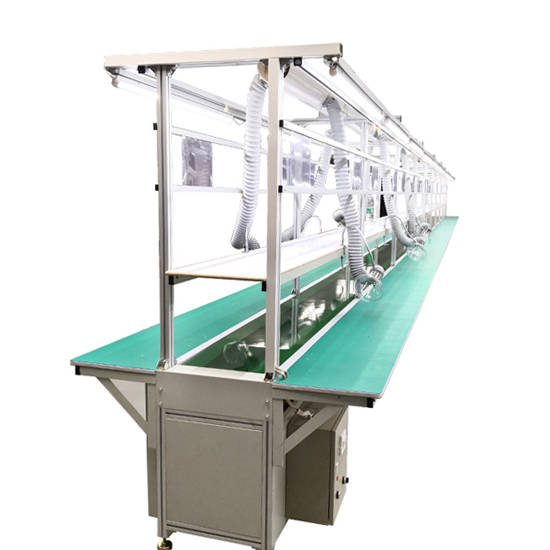
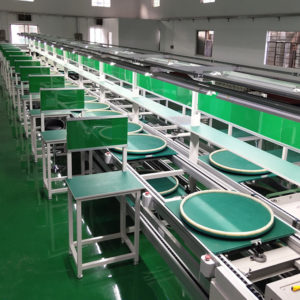
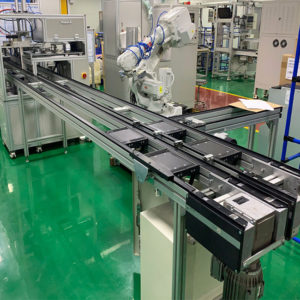
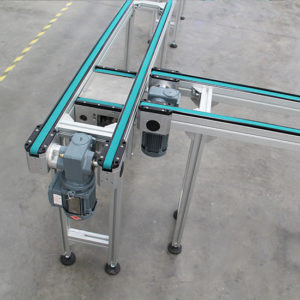
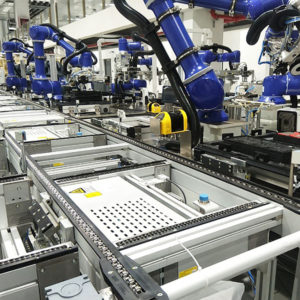

Mga pagsusuri
Wala pang mga review.